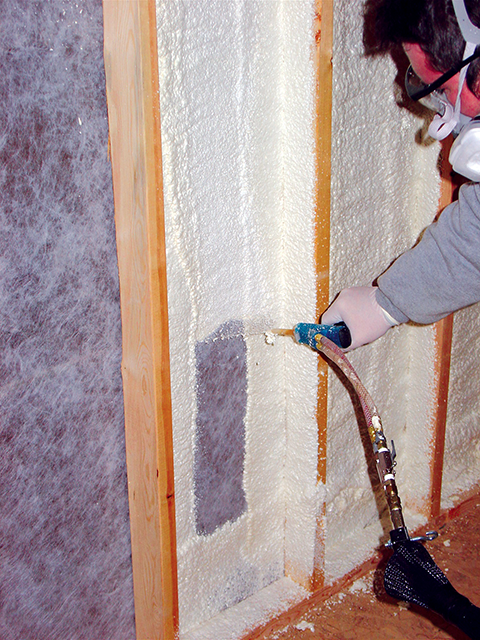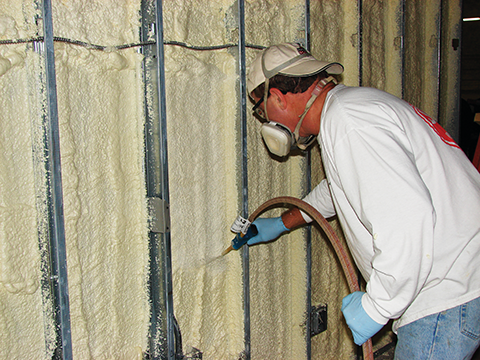
Sound-deadening ratings
Design teams should be armed with the knowledge of which sprayed polyurethane foams are best for various applications. Two ratings ought to be considered by building professionals when considering SPF for sound insulation: sound transmission class (STC) and noise reduction coefficient (NRC).
STC ratings indicate how well a wall assembly blocks airborne sound. Throughout the United States, this is one of the most common evaluations of how well ceilings, floors, doors, exterior, and interior walls block airborne sound. STC ratings reflect decibel reduction among these barriers. Deploying a SPF sound-barrier can help interior residential walls maintain an STC rating of 35 at 76.2-mm (3-in.) thickness, at which loud speech is rendered unintelligible; comparatively, a wall without comparable insulation is typically rated at 25, through which normal speech can be easily understood under average conditions.
NRC ratings are a single-number index for rating how absorptive of sound a material is, in which ‘0’ indicates a material perfectly reflective of sound, and ‘1’ indicates a material is perfectly absorptive of sound. At 76.2-mm thickness, sprayed polyurethane foam insulation can help achieve an NRC rating of .70.
Sound deadening for added value
It is important to note while SPF makes for a useful multipurpose solution with its sound-deadening properties, it is not the only available method for sound-deadening measures. More comprehensive sound-deadening results can be had from dedicated products.
The value of sprayed polyurethane foam as an acoustic measure is it is another addition to an already robust range of benefits the material can bring to any application. It can also be useful for irregularly shaped areas, and is easily workable around obstructions that may exist within wall cavities through its precise dispensation method. Sprayed polyurethane foam helps create an air barrier that blocks air movement throughout building cavities, preventing air leakage that can account for 25 to 40 percent of heating and cooling costs for buildings, according to the U.S. Department of Energy (DOE).
Additionally, by seamlessly filling wall voids, sprayed polyurethane foam can help prevent moisture carried through the air from accumulating within these spaces, which would otherwise have the potential to lead to mold and mildew buildup inside wall cavities. Sprayed polyurethane foam fills cracks and crevices where this could become problematic, and additionally seals passageways where moisture could infiltrate.
Traditional insulation materials and sound-deadening materials are often more cumbersome to work with and can require additional construction if applying within an existing structure. These materials often do not provide as many benefits by themselves, making SPF a cost-effective, multi-purpose choice.

Specifying the appropriate SPF
Low-density, open-cell foams typically allow for the appropriate amount of absorption to strike the proper balance between the sound deadening and insulation needs in commercial applications. By filling both of these needs, potential savings can be had on additional air-sealing materials required to meet some local and state building energy code requirements. In addition to the noise control benefit, open-cell SPF can help to dramatically reduce air leakage, and lowering heating and cooling costs.
To bolster the environmental and energy-saving benefits of a sprayed polyurethane foam installation, specifying a product with enhanced environmental properties can be valuable. Since contractors are spraying within office spaces and residences, a product emitting low volatile organic compounds (VOCs) makes for an appropriate choice. There are several certifications project teams can look for when specifying a product with low VOCs, one of the most common being GreenGuard.
GreenGuard-certified products meet world-renowned, comprehensive standards for low emissions of VOCs, helping to maintain healthier indoor environments. This can be an important consideration when choosing sprayed polyurethane foam, for both designers and building owners.
It is also important to consider using products that do not have stipulations on being left exposed, as it creates worry with the building owner/occupants. Further, it is likely such materials may not meet building codes in the future, given the way environmental considerations are becoming increasingly more prominent in building codes.
Conclusion
As is always the case when working with a specialized building material, it is important for builders and architects to contract with trained and qualified sprayfoam installers—keeping an eye out for contractors who are certified through the Spray Polyurethane Foam Alliance’s (SPFA’s) Professional Certification Program is a good place to start. Programs like this one help ensure the contracted professional is trained in the proper methods for SPF installation, and can make a reliable recommendation about the appropriate product for a given job.
It is also critical to keep in mind the need for coordination with mechanical and electrical trades to ensure all applicable systems have been installed (and tested) within walls to receive SPF because they will not be accessible later. This is something the onsite contractor and architect should be working toward in the installation plan.
Kristen Lewis is the national sales manager at Fomo Products. She has been with the company for more than 15 years and has served in multiple roles. As an accredited Building Performance Institute (BPI) Certified Building Analyst, Lewis focuses on finding solutions to building performance and weatherization challenges. She can be contacted at klewis@fomo.com.





I think it’s cool that spray foam is also good for sound proofing as well as normal insulation. Being a guy who is heavily involved in music, it would be nice to have sound not travel to far out of my house. I already bother my neighbors enough!
Wow, this is amazing. I didn’t realize that spray foam could be used for sound proofing as well. Really good to know, thanks for sharing!
It should be clarified that the use of spray foam for acoustic purposes is mainly only effective within a closed wall and it acts primarily as a sound deadener or acoustic mass, not a sound absorber. To be more specific, if one is looking to attentuate or absorb the sound within a space, spray foam is not very effective for absorption of sound. Rather, the foam within the wall minimizes the ability of the sound to pass through the wall through resonance (i.e. vibration). To absorb the sound, one would need to use an absorptive material like an acoustic wall panel, acoustic ceiling or carpet.
Paul, any idea for soundproofing, or at least a way to substantially reduce noise between condo interior walls? I’m looking for safe low VOC air qualify, fire proof or retardant and not too expensive way to prevent voices from traveling between units in a town house.
Thanks, Mike
I am looking for a SPF that is primarily used for acoustic dampening and absorption. If anyone knows of a brand that has a high density (mass per cu.ft.) and is visco-elastic when cured, please leave comment. It does not need to be high expansion.
This is very helpful. Might try this.
Hi All,
STC and NRC mostly deals with airborne accoustics, Can anybody help me on the IIC(Impact Isolation Class)study on SPF
Thanks
Be sure to compare the “Closed Cell” foam and “Open Cell” foam if you are planning on sound attenuation. Also consider the value of an air gap so you don’t create a rigid structure which passes sound thru the entire assembly. Some assemblies include both a Open Cell foam layer and a traditional fiberglass layer for maximum effect. Stay quiet.
Gary can you expand on using Open and fiberglass for sound?
Great Post, Thank you for giving such an informative article! Must read related Batt Insulation
Most Welcome. Hope to provide you with such informative content in the future too.
As a relied on Spray Foam Insulation Contractor in Toronto, Kitchener, Brampton in addition to Mississauga, we specialize inside the application of premium spray foam insulation. Our professional technicians use contemporary systems and techniques to create an unbroken thermal barrier in your home. Spray foam insulation bureaucracy a durable and hermetic seal, preventing warmth loss, air leakage, and moisture infiltration. This resulted in advanced energy efficiency, decreased noise transmission, and more suitable indoor consolation.
Outstanding job on the insulation project! The team was efficient, friendly, and delivered excellent results.